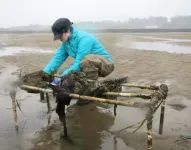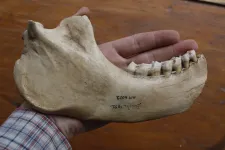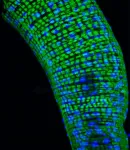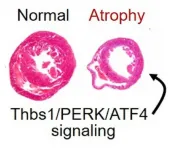(Press-News.org) Wastewater treatment facilities clean the water that goes down our sinks and flushes our toilets, but they do not remove everything. A recent study by Portland State researchers detected low levels of pharmaceuticals and personal care product chemicals in oysters the team deployed at various distances from wastewater effluent pipes along the Oregon and Washington coast. Elise Granek, professor of environmental science and management at Portland State University, and Amy Ehrhart, a recent graduate of PSU's Earth, Environment, and Society doctoral program, conducted the study.
To explore how aquatic pollution varies based on proximity to wastewater facilities, Ehrhart and Granek placed one-week-old Pacific oysters at wastewater sites (not approved by state agencies as oyster growing sites) and near oyster aquaculture sites (approved for growing oysters) along the Oregon and Washington coastline. Nine and twelve months later, they collected the oysters, measured their health and size, and tested their tissues for pharmaceuticals and chemicals called alkylphenols, which are used in a variety of personal care and industrial products. Alkylphenols are endocrine disruptors that can alter the growth and reproduction of aquatic organisms.
Out of the 63 compounds tested, Granek and Ehrhart found only six in the oysters. The two pharmaceuticals detected in the oysters were miconazole, an over-the-counter drug for fungal infections like Athlete's foot, and virginiamycin, a veterinary antibiotic used in livestock. As expected, the concentrations of pharmaceuticals were higher near the wastewater sites. The condition of the oysters was also poorer at wastewater sites compared to the sites near oyster farms.
Four types of alkylphenols were found in oysters from all the sites.
"This makes sense because they are really ubiquitous," said Ehrhart. "They're found in all sorts of common household and industrial products."
Everyday products like detergents, cosmetics, soaps, and cleaners often contain alkylphenols as do forestry pesticide application mixtures. While detectable, the chemical levels were much lower than reported in other estuarine studies near more populated areas.
"The levels that we found were very low," Ehrhart said. She noted that the levels detected are significantly lower than the Environmental Protection Agency's no effect level for nonylphenol exposure in humans and the Food and Drug Administration's allowable limits for antibiotics in meat. "It's unlikely to pose a risk to human consumers of shellfish," she said. Additionally, the Oregon Department of Agriculture and Washington Department of Health continually monitor and approve areas for shellfish growing to ensure they meet strict water quality standards for food safety.
That said, the very presence of these chemicals in oysters relatively far from wastewater sites and in sparsely populated coastal areas suggests that current wastewater treatment technology, stormwater mitigation strategies, and industrial use guidelines for alkylphenol use may not be sufficient. This could be bad news for aquatic animals, including shellfish.
"It's not an aquaculture-driven problem. It's coming from upstream, but it's making its way to aquaculture and it may be negatively affecting oysters, given other studies on how alkylphenols can affect animals," says Granek. "So it really points to a need to address the sources of these alkylphenols."
Granek suggested that possible solutions for this kind of aquatic pollution include upgrading wastewater treatment plants and creating regulations that target the use of industrial products containing alkylphenols.
Individuals can also do their part by not flushing medications down sinks or toilets and instead using drop boxes available at many pharmacies.
"For the pharmaceuticals it's better disposal, for the alkylphenols it's buying products that don't have them," said Ehrhart.
It can be difficult to determine which products contain alkylphenols just from reading ingredient lists, so Ehrhart suggests looking for the EPA's Safer Choice label. "If you see that on cleaning products and detergents, that means that those products don't have alkylphenols, so they are better for the environment."
The study was published in Marine Pollution Bulletin on June 20.
INFORMATION:
Researchers at Harvard University and the Broad Institute of MIT and Harvard have created a first detailed atlas of a critical region of the developing mouse brain, applying multiple advanced genomic technologies to the part of the cerebral cortex that is responsible for processing sensation from the body. By measuring how gene activity and regulation change over time, researchers now have a better understanding of how the cerebral cortex is built, as well as a brand new set of tools to explore how the cortex is affected in neurodevelopmental disease. The study is published in the journal Nature.
"We have had a long-standing interest in understanding the development of the mammalian cerebral cortex, as it is ...
UNIVERSITY PARK, Pa. -- Using an unusually well-preserved subfossil jawbone, a team of researchers -- led by Penn State and with a multi-national team of collaborators including scientists from the Université d'Antananarivo in Madagascar -- has sequenced for the first time the nuclear genome of the koala lemur (Megaladapis edwardsi), one of the largest of the 17 or so giant lemur species that went extinct on the island of Madagascar between about 500 and 2,000 years ago. The findings reveal new information about this animal's position on the primate family tree and how it interacted with its environment, which could help in understanding the impacts of past lemur extinctions on Madagascar's ecosystems.
"More than 100 species of lemurs live on Madagascar today, ...
To better understand the role of bacteria in health and disease, National Institutes of Health researchers fed fruit flies antibiotics and monitored the lifetime activity of hundreds of genes that scientists have traditionally thought control aging. To their surprise, the antibiotics not only extended the lives of the flies but also dramatically changed the activity of many of these genes. Their results suggested that only about 30% of the genes traditionally associated with aging set an animal's internal clock while the rest reflect the body's response to bacteria.
"For ...
COLUMBUS, Ohio - When the summer sun blazes on a hot city street, our first reaction is to flee to a shady spot protected by a building or tree.
A new study is the first to calculate exactly how much these shaded areas help lower the temperature and reduce the "urban heat island" effect.
Researchers created an intricate 3D digital model of a section of Columbus and determined what effect the shade of the buildings and trees in the area had on land surface temperatures over the course of one hour on one summer day.
"We can use the information from our model to formulate guidelines for community greening and tree planting efforts, and even where to locate buildings to maximize shading on other buildings and roadways," said Jean-Michel Guldmann, co-author of the study and ...
A new tool to help conserve one of the UK's most threatened mammals has been released today, with the publication of the first high-quality reference genome for the European water vole. The genome was generated by scientists at the Wellcome Sanger Institute, in collaboration with animal conservation charity the Wildwood Trust, as part of the Darwin Tree of Life Project.
The genome, published today (24 June 2021) through Wellcome Open Research, is openly available as a reference for researchers seeking to assess water vole population genetics, better understand how the species has evolved and to manage reintroduction efforts.
The European water vole (Arvicola ...
A team from Japan and the United States has identified the design principles for creating large "ideal" proteins from scratch, paving the way for the design of proteins with new biochemical functions.
Their results appear June 24, 2021, in Nature Communications.
The team had previously developed principles to design small versions of what they call "ideal proteins," which are structures without internal energetic frustration.
Such proteins are typically designed with a molecular feature called beta strands, which serve a key structural role for the molecules. In ...
Our planet's strongest ocean current, which circulates around Antarctica, plays a major role in determining the transport of heat, salt and nutrients in the ocean. An international research team led by the Alfred Wegener Institute has now evaluated sediment samples from the Drake Passage. Their findings: during the last interglacial period, the water flowed more rapidly than it does today. This could be a blueprint for the future and have global consequences. For example, the Southern Ocean's capacity to absorb CO2 could decrease, which would in turn intensify climate change. The study has now been published in the journal Nature Communications.
The Antarctic Circumpolar Current (ACC) is the world's strongest ocean ...
Indonesia's volcanoes are among the world's most dangerous. Why? Through chemical analyses of tiny minerals in lava from Bali and Java, researchers from Uppsala University and elsewhere have found new clues. They now understand better how the Earth's mantle is composed in that particular region and how the magma changes before an eruption. The study is published in Nature Communications.
Frances Deegan, the study's first author and a researcher at Uppsala University's Department of Earth Sciences, summarises the findings.
"Magma is formed in the mantle, and the composition of the mantle under Indonesia used to be only partly known. ...
In many situations, heart muscle cells do not respond to external stresses in the same ways that skeletal muscle cells do. But under some conditions, heart and skeletal muscles can both waste away at fatally rapid rates, according to a new study led by experts at Cincinnati Children's.
The new findings, based on studies of mouse models, represent an important milestone in a long effort to prevent or even reverse cardiac atrophy, which can lead to fatal heart failure when the body loses large amounts of weight or experiences extended periods of weightlessness in space. Detailed findings were published online June 24, 2021, in Nature Communications.
"NASA is very interested in cardiac atrophy," says Jeffery Molkentin, PhD, Co-Director ...
UNIVERSITY OF TORONTO
TORONTO, ON - A new study from researchers at the University of Toronto found that 63% of Canadians with migraine headaches are able to flourish, despite the painful condition.
"This research provides a very hopeful message for individuals struggling with migraines, their families and health professionals," says lead author Esme Fuller-Thomson, who spent the last decade publishing on negative mental health outcomes associated with migraines, including suicide attempts, anxiety disorders and depression. "The findings of our study have contributed to a major paradigm shift for me. There are important lessons to be learned from those who are flourishing."
A migraine headache, which afflicts ...





